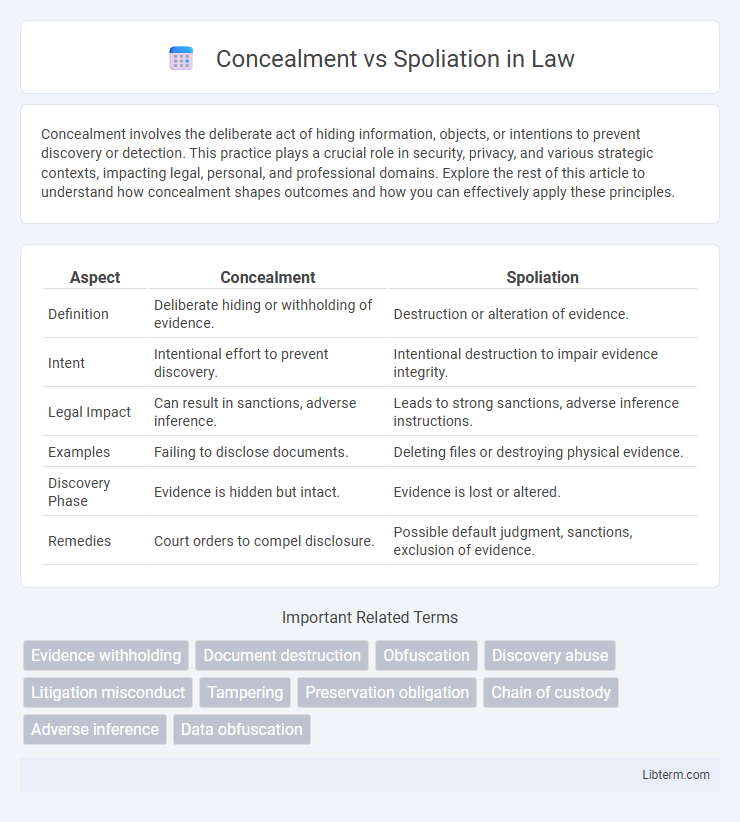Concealment involves the deliberate act of hiding information, objects, or intentions to prevent discovery or detection. This practice plays a crucial role in security, privacy, and various strategic contexts, impacting legal, personal, and professional domains. Explore the rest of this article to understand how concealment shapes outcomes and how you can effectively apply these principles.
Table of Comparison
| Aspect | Concealment | Spoliation |
|---|---|---|
| Definition | Deliberate hiding or withholding of evidence. | Destruction or alteration of evidence. |
| Intent | Intentional effort to prevent discovery. | Intentional destruction to impair evidence integrity. |
| Legal Impact | Can result in sanctions, adverse inference. | Leads to strong sanctions, adverse inference instructions. |
| Examples | Failing to disclose documents. | Deleting files or destroying physical evidence. |
| Discovery Phase | Evidence is hidden but intact. | Evidence is lost or altered. |
| Remedies | Court orders to compel disclosure. | Possible default judgment, sanctions, exclusion of evidence. |
Understanding Concealment and Spoliation
Concealment involves intentionally hiding or withholding evidence to prevent its discovery, often to mislead investigations or legal proceedings. Spoliation refers to the destruction, alteration, or failure to preserve relevant evidence, which can hinder the fact-finding process and lead to legal sanctions. Both actions undermine justice, with concealment focusing on secrecy and spoliation emphasizing damage or loss of evidence integrity.
Legal Definitions: Concealment vs Spoliation
Concealment refers to the intentional act of hiding or withholding evidence relevant to a legal investigation or proceeding. Spoliation involves the destruction, alteration, or failure to preserve evidence that is crucial to a case, which can lead to sanctions or adverse inferences by the court. Legal definitions distinguish concealment as passive non-disclosure, whereas spoliation implies active interference with evidence integrity.
Key Elements of Concealment
Concealment involves intentional actions to hide or withhold evidence, affecting the accuracy and completeness of information in legal or investigative contexts. Key elements of concealment include a deliberate act to obscure or suppress relevant facts, knowledge of the material nature of the information, and an intent to prevent discovery or access by opposing parties. These components differentiate concealment from mere negligence, emphasizing purposeful deception to influence outcomes.
Essential Characteristics of Spoliation
Spoliation involves the intentional destruction, alteration, or failure to preserve evidence relevant to a legal proceeding, distinguishing it from mere concealment, which entails hiding but not destroying evidence. Key characteristics of spoliation include the deliberate act to impair evidence integrity, the duty to preserve the evidence once litigation is reasonably anticipated, and the causal link between the spoliation and potential prejudice against the opposing party. Courts often impose sanctions or adverse inference instructions when spoliation is proven, emphasizing the significance of maintaining evidentiary integrity.
How Concealment Impacts Legal Proceedings
Concealment in legal proceedings obstructs the discovery process by hiding crucial evidence, which can lead to unfair trials and misjudgments. It compromises the integrity of the judicial system by preventing courts from fully assessing the facts necessary for just decisions. Legal consequences of concealment may include sanctions, adverse inferences, or even dismissal of claims, significantly impacting case outcomes.
Consequences of Spoliation in Court
Spoliation of evidence in court leads to severe legal consequences including adverse inference rulings, where the judge or jury assumes the destroyed or hidden evidence was unfavorable to the offending party. Courts may impose sanctions such as fines, dismissal of claims, or default judgments to penalize parties that intentionally conceal or destroy relevant evidence. The severity of penalties depends on the degree of culpability and harm caused, emphasizing the critical importance of preserving evidence during litigation.
Case Studies: Concealment and Spoliation Compared
Case studies reveal that concealment involves intentionally hiding evidence while spoliation refers to the destruction or alteration of evidence, both critically impacting legal outcomes. In landmark cases such as *Zubulake v. UBS Warburg*, concealment led to sanctions due to failure to disclose relevant electronic evidence, whereas in *Pension Committee v. Banc of America Securities*, spoliation resulted from the deletion of critical documents, triggering adverse inferences. Analysis of these cases underscores the necessity of stringent evidence preservation protocols to prevent judicial penalties and ensure fair trial processes.
Preventing Concealment and Spoliation
Preventing concealment and spoliation requires implementing robust document retention policies and leveraging advanced forensic data preservation tools to track and secure relevant electronic evidence. Legal teams must conduct timely audits and issue preservation notices to ensure compliance with regulatory mandates and avoid sanctions. Employing blockchain technology and AI-driven monitoring systems enhances transparency and detection of any attempts to alter or destroy crucial information during litigation or investigations.
Legal Remedies and Penalties
Legal remedies for concealment typically involve injunctions, fines, and compensatory damages aimed at addressing intentional hiding of evidence. In cases of spoliation, courts may impose harsher sanctions such as adverse inference instructions, default judgments, or contempt penalties to deter destruction or alteration of evidence. Both concealment and spoliation can severely impact the outcome of litigation by influencing judicial decisions and undermining the integrity of the legal process.
Concealment vs Spoliation: Choosing the Right Defense Strategy
Choosing the right defense strategy between concealment and spoliation hinges on understanding their legal distinctions and consequences. Concealment involves intentionally hiding or withholding evidence, often leading to severe sanctions and damage to credibility, whereas spoliation refers to the destruction or alteration of evidence, which can result in adverse inference or default judgment. Legal professionals must assess the intent, evidence preservation policies, and case specifics to determine the most effective approach that minimizes liability while complying with judicial standards.
Concealment Infographic

 libterm.com
libterm.com